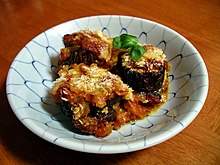Parmigiana
Parmigiana (also ... alla parmigiana , 'Parma-style') is a vegetable casserole that comes from the Neapolitan and Sicilian cuisine and is widespread in southern Italy.
preparation
For the dish, vegetables ( e.g. aubergines , zucchini , asparagus or artichokes ) are cooked in a pan with Parmesan cheese and tomato sauce . The best-known variant of the dish is the Parmigiana di melanzane , for which aubergine slices, basil , mozzarella , tomato sauce and Parmesan cheese (ital .: parmigiano ) are processed in a flour / egg coating .
The preparation of the dish is laborious, as a tomato sauce has to be cooked and the vegetables must be pre-cooked (mostly baked). Like most vegetable casseroles in Italy, the Parmigiana is not consumed hot, but lukewarm or room warm, which makes it a suitable dish for picnics . It is considered a 'main course' (secondo piatto) in Italian cuisine , but is also often served cold as part of the starters (antipasti) .
history
According to the Devoto-Oli lexicon , the name alla Parmigiana refers to the layering or slicing of vegetables in a casserole and not to the addition of Parmesan cheese.
The age of the recipe known today can be narrowed down by dating the introduction of its ingredients: the aubergine was probably imported from Asia to Europe by Arab traders in the early Middle Ages. As with many nightshade plants, there were initially reservations about this fruit, and it was not until the 13th century that it became common in southern European cuisine. The tomato , which was imported from America at the end of the 15th century, but was only recorded as a food in Italy in the second half of the 17th century, had a similar experience . Thus the time around the turn of the 18th century is assumed to be the probable time of origin of the court.
In the famous treatise Il Cuoco Galante by Vincenzo Corrado , the oldest recipe alla parmigiana can be found on page 161 , whereby the basic recipe is described with zucchini and tomato sauce, mozzarella and basil are missing:
“Delle zucche lunghe alla parmigiana
Le zucche lunghe devono essere nè troppo lunghe, né piccole. Prima di cuocerle bisogna raderle d'intorno, e tagliarle in sottili fat rotonde; poi polverate di sale, per qualche tempo, acciocché mandino fuori un certo cattivo umore, e si renda la loro carne piacevole, da usarla in quelle manner che si dirà, si spremono tra le mani, o tra due tondi, s'infarinino, e si friggano nello strutto. Si servano in un piatto tramezzate di parmigiano, e butirro, coverte con salsa di gialli di uova, e butirro, rassodate nel forno. "
“ About zucchini the Parma way
The zucchini shouldn't be too long or too short. Before cooking, peel them all around and cut them into thin, round slices; then sprinkle them with salt so that they excrete a certain foul liquid and their flesh becomes pleasant. To use them in the way described below, they are squeezed out with the hands or between two slices, floured and baked in lard . Serve on a plate, layered with parmesan and butirro (pear-shaped, butter-filled buffalo cheese from southern Italy), covered with a sauce made from egg yolk and butirro, baked in the oven. "
In 1839 Ippolito Cavalcanti's treatise Cucina teorico pratica ('Theoretical-Practical Kitchen') was accompanied by an appendix to the Cusina casarinola co la lengua napoletana ('Housewife's Kitchen in Napoletan Language'), in which the recipe first appeared in its current form:
“Melanzane alla parmigiana
… e le farai friggere; e poi le disporrai in una teglia a strato con il formaggio, basilico e brodo di stufato o con salsa di pomodoro; e coperte le farai stufare. "
“Parma-style
aubergines ... and bake them out; then you spread them in layers on a tray with the cheese, basil and roast or tomato sauce and let them stew covered. "
literature
- Lejla Mancusi Sorrentino, Vincenzo Corrado (eds.): Il cuoco galante . Reprint of the Napoletan edition of 1793, Grimaldi & C. Editori
- Ippolito Cavalcanti: Cucina casereccia in lingua napoletana . Edizioni Il Profilo
- Terence Scully: L'arte della cucina nel Medioevo. Storia, ricette e personaggi dell'epoca favolosa della tavola . Piemme, Casale Monferrato 1997
- The Art of Cookery in The Middle Ages . Boydell Press, Woodbridge 1995
- Alessandro Molinari Pradelli: Italy in tavola - Sicilia . EMMEBI Edizioni, Florence
- Giuseppe Coria: I Sapori di Sicilia . Vito Cavallotto Editore, Palermo 1981
- Enrico Alagna: Cucina Siciliana. Sapori, odori e fantasie di una grande tradizione . Nuova Ipsa
- Vittoria Cerabolini, Marianne Kaltenbach: From Italy's Kitchens . Hallwag, Bern 1982, ISBN 3-444-10238-0
- Franco Benussi, Reinhardt Hess, Sabine Sälzer: The real Italian cuisine . Gräfe & Unzer, Munich 2002, ISBN 3-7742-1102-7
Individual evidence
- ↑ Vincenzo Corrado: Il Cuoco Galante . Grimaldi & C., 1793, ISBN 978-88-98199-04-4 (reprint from 2013).
